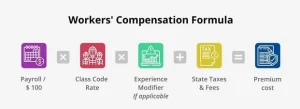Get a better understanding how Workers’ Comp premiums are calculated with answers to these questions:
- What Factors Contribute to Figuring Workers’ Comp Costs?
- What are Workers’ Comp Class Codes?
- How Can I Find My Experience Modifier?
- How is My Workers’ Comp Premium Calculated?
What Factors Contribute to Figuring Workers’ Comp Costs?
Workers’ Comp rates are typically a fraction of every $100 of payroll, but actual varies business to business. Some jobs are more dangerous than others. As a result, the hazards faced in certain lines of work can be more severe. For instance: a contractor in landscaping company faces a higher risk of injury than an employee of a library.
If an employee works in multiple roles with varying risk factors, categorizing labor according to the various class codes can help employers control insurance costs.
There are many factors that contribute to figuring Workers’ Comp costs. Some of those include:
- Location: Your business region could affect the cost of your policy. Workers’ Comp is regulated at the state level, so your insurance rate will rely partly on the state where the work is performed.
- Type of Work: Your industry and individual risk factor also determines Workers’ Comp premium, which is calculated from your assigned class codes (more on those below).
- Payroll: The gross total payroll of each employee also figures into your business’s Workers’ Comp cost.
- Claims History: Private insurance issuers have different hazard history claims, separate from the state’s regulatory policy.
What are Workers’ Comp Class Codes?
Workers’ Comp class codes are used by insurance companies to categorize your type of work based upon estimated risk. Class codes are typically four-digit numbers assigned to businesses for the industry they belong to.
To look up the class code for your business, try a search here: Online List of NCCI Codes & Phraseology by State | Class Codes.
How Can I Find My Experience Modifier?
Your businesses’ experience modifier, or eMod, is a number that is used to indicated how your organization’s Workers’ Comp claims experience compares to other businesses similar in size and industry.
Your eMod usually considers three years of claims history and is often calculated by the National Council on Compensation Insurance (NCCI) or your stated rating bureau.
Please note: not all businesses have an eMod. Consult with your agent for more information.
How Is Workers’ Compensation Premium Calculated?
Your employee payroll, class code and eMod are all needed to calculate your Workers’ Comp premium. The formula for this calculation is:
Payroll (per $100) X Class Code Rate X Experience Modifier (if applicable) + State Taxes & Fees = Premium

Note: the NCCI creates the rules for premium computations for most states, with rules varying according to which state you live in. The state bureau then outlines the rate and baseline cost of Workers’ Comp premium by analyzing hazard data and compensation claims.
Get a Quote
If you would like to know more about our Workers’ Compensation coverage offerings, check out our product guide. If you’re ready to get a quote for your small business, reach out to our Customer Service team today at (800) 825-9489 to get a list of appointed insurance agents in your state.
This Workers’ Compensation article is not intended to be exhaustive, provide insurance counseling, nor should it be construed as legal advice. Readers should contact their insurance professional or an attorney for advice.


